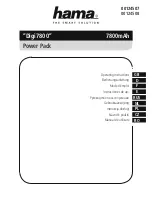
8
Do not modify the plug provided - if it will not fit the
outlet, have the proper outlet installed by a qualified
electrician.
Improper connection of the equipment-grounding
conductor can result in a risk of electric shock. The
conductor with insulation having an outer surface
that is green with or without yellow stripes is the
equipment-grounding conductor. If repair or
replacement of the electric cord or plug is
necessary, do not connect the equipment-grounding
conductor to a live terminal.
Check with a qualified
electrician or service pe
r
sonnel if the grounding
instructions are not completely understood, or if
in doubt as to whether the tool is properly
grounded. Failure to comply may cause serious
or fatal injury.
Use only 3-wire extension cords that have 3-prong
grounding plugs and 3-pole receptacles that accept
the tool's plug.
Repair or replace damaged or worn cord
immediately.
2. Grounded, cord-connected tools intended for use
on a supply circuit having a nominal rating
less than
150
volts:
This tool is intended for use on a circuit that has an
outlet that looks like the one illustrated in
A,
Figure
7-1. An adapter, shown in
B
and
C
, may be used to
connect this plug to a 2-pole receptacle as shown in
B
if a properly grounded outlet is not available. The
temporary adapter should be used only until a
properly grounded outlet can be installed by a
qualified electrician.
This adapter is not permitted in
Canada.
The green-colored rigid ear, lug, and the
like, extending from the adapter must be connected
to a permanent ground such as a properly grounded
outlet box.
3. Grounded, cord-connected tools intended for use
on a supply circuit having a nominal rating between
150 - 250 volts
, inclusive:
This tool is intended for use on a circuit that has an
outlet that looks like the one illustrated in
D,
Figure
7-1. A grounding plug may be installed, that looks
like the plug illustrated in
D
; or the grinder may be
“hard-wired” to a panel, provided there is a
disconnect for the operator.
Make sure the tool is connected to an outlet having
the same configuration as the plug. No adapter is
available or should be used with this tool. If the tool
must be reconnected for use on a different type of
electric circuit, the reconnection should be made by
qualified service personnel; and after reconnection,
the tool should comply with all local codes and
ordinances.
7.2
Extension cords
The use of extension cords is discouraged. Try to
position equipment near the power source. If an
extension cord becomes necessary, use only three-
wire extension cords that have three-prong
grounding type plugs and three-prong receptacles
that accept the tool's plug. Replace or repair
damaged or worn cord immediately.
Make sure your extension cord is good condition,
and is heavy enough to carry the current your
product will draw. An undersized cord will cause a
drop in line voltage resulting in loss of power and
overheating.
Table 1 shows the correct size to use depending on
cord length and nameplate ampere rating. If in doubt,
use the next heavier gage. The smaller the gage
number (AWG), the heavier the cord.
Ampere
Rating
Volts
Total length of
cord in feet
More
Than
Not
More
Than
120
240
25
50
50
100
100
200
150
300
AWG
0 6 18
16
16 14
6 10
18
16
14 12
10 12
16
16
14 12
12 16
14
12
Not
Recommended
Extension Cord Recommendations
Table 1
7.3
Voltage conversion
To change voltage input to 230-volt on the IBG-
8VSB Buffer, remove existing plug from power cable
and attach a UL/CSA listed plug designed for 230V
power.
8.0
Operation
Buffing wheels vary according to material and
structure, and range from aggressive wheels that
even out high spots and remove surface defects
(“cutting”), to finer wheels that bring out the brilliant
luster of the metal surface (“coloring”). The buffing
wheel surface may be straight or biased (cut at an
angle).
The JET Buffer is provided with two buffing wheels:
a full spiral-sewn wheel for general polishing of
metals, and a looser or half spiral-sewn wheel for
final polishing and coloring of metals.
A compound (not provided) should be selected for
the specific wheel and work to be done. Generally
for spiral-sewn cloth wheels, a brown (Tripoli),
compound will be used for basic cutting and
polishing, followed by a white compound for
coloring. Red (Jeweller’s Rouge) compound is often
used for further enhancement to gain a mirror-like
surface. Consult experienced metalworkers and
online resources for specific recommendations on
buffing wheels and their application.






































